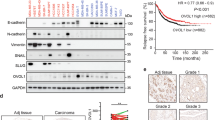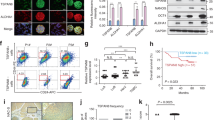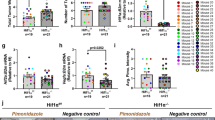Abstract
Tumor progression is intrinsically tied to the clonal selection of tumor cells with acquired phenotypes allowing to cope with a hostile microenvironment. Hypoxia-inducible factors (HIFs) master the transcriptional response to local tissue hypoxia, a hallmark of solid tumors. Here, we report significantly longer patient survival in breast cancer with high levels of HIF-2α. Amphiregulin (AREG) and WNT1-inducible signaling pathway protein-2 (WISP2) expression was strongly HIF-2α-dependent and their promoters were particularly responsive to HIF-2α. The endogenous AREG promoter recruited HIF-2α in the absence of a classical HIF–DNA interaction motif, revealing a novel mechanism of gene regulation. Loss of AREG expression in HIF-2α-depleted cells was accompanied by reduced activation of epidermal growth factor (EGF) receptor family members. Apparently opposing results from patient and in vitro data point to an HIF-2α-dependent auto-stimulatory tumor phenotype that, while promoting EGF signaling in cellular models, increased the survival of diagnosed and treated human patients. Our findings suggest a model where HIF-2α-mediated autocrine growth signaling in breast cancer sustains a state of cellular self-sufficiency, thereby masking unfavorable microenvironmental growth conditions, limiting adverse selection and improving therapy efficacy. Importantly, HIF-2α/AREG/WISP2-expressing tumors were associated with luminal tumor differentiation, indicative of a better response to classical treatments. Shifting the HIF-1/2α balance toward an HIF-2-dominated phenotype could thus offer a novel approach in breast cancer therapy.
This is a preview of subscription content, access via your institution
Access options
Subscribe to this journal
Receive 50 print issues and online access
$259.00 per year
only $5.18 per issue
Buy this article
- Purchase on Springer Link
- Instant access to full article PDF
Prices may be subject to local taxes which are calculated during checkout








Similar content being viewed by others
References
Aprelikova O, Wood M, Tackett S, Chandramouli GV, Barrett JC . (2006). Role of ETS transcription factors in the hypoxia-inducible factor-2 target gene selection. Cancer Res 66: 5641–5647.
Banerjee S, Dhar G, Haque I, Kambhampati S, Mehta S, Sengupta K et al. (2008). CCN5/WISP-2 expression in breast adenocarcinoma is associated with less frequent progression of the disease and suppresses the invasive phenotypes of tumor cells. Cancer Res 68: 7606–7612.
Bertout JA, Patel SA, Simon MC . (2008). The impact of O2 availability on human cancer. Nat Rev Cancer 8: 967–975.
Bordoli MR, Stiehl DP, Borsig L, Kristiansen G, Hausladen S, Schraml P et al. (2011). Prolyl-4-hydroxylase PHD2- and hypoxia-inducible factor 2-dependent regulation of amphiregulin contributes to breast tumorigenesis. Oncogene 30: 548–560.
Brugarolas J, Lei K, Hurley RL, Manning BD, Reiling JH, Hafen E et al. (2004). Regulation of mTOR function in response to hypoxia by REDD1 and the TSC1/TSC2 tumor suppressor complex. Genes Dev 18: 2893–2904.
Covello KL, Kehler J, Yu H, Gordan JD, Arsham AM, Hu CJ et al. (2006). HIF-2alpha regulates Oct-4: effects of hypoxia on stem cell function, embryonic development, and tumor growth. Genes Dev 20: 557–570.
Cummins EP, Taylor CT . (2005). Hypoxia-responsive transcription factors. Pflugers Arch 450: 363–371.
Dewhirst MW, Cao Y, Moeller B . (2008). Cycling hypoxia and free radicals regulate angiogenesis and radiotherapy response. Nat Rev Cancer 8: 425–437.
Elvert G, Kappel A, Heidenreich R, Englmeier U, Lanz S, Acker T et al. (2003). Cooperative interaction of hypoxia-inducible factor-2alpha (HIF-2alpha) and Ets-1 in the transcriptional activation of vascular endothelial growth factor receptor-2 (Flk-1). J Biol Chem 278: 7520–7530.
Elvidge GP, Glenny L, Appelhoff RJ, Ratcliffe PJ, Ragoussis J, Gleadle JM . (2006). Concordant regulation of gene expression by hypoxia and 2-oxoglutarate-dependent dioxygenase inhibition: the role of HIF-1alpha, HIF-2alpha, and other pathways. J Biol Chem 281: 15215–15226.
Franovic A, Holterman CE, Payette J, Lee S . (2009). Human cancers converge at the HIF-2alpha oncogenic axis. Proc Natl Acad Sci USA 106: 21306–21311.
Fritah A, Saucier C, De Wever O, Bracke M, Bieche I, Lidereau R et al. (2008). Role of WISP-2/CCN5 in the maintenance of a differentiated and noninvasive phenotype in human breast cancer cells. Mol Cell Biol 28: 1114–1123.
Gatenby RA, Silva AS, Gillies RJ, Frieden BR . (2009). Adaptive therapy. Cancer Res 69: 4894–4903.
Gatenby RA, Smallbone K, Maini PK, Rose F, Averill J, Nagle RB et al. (2007). Cellular adaptations to hypoxia and acidosis during somatic evolution of breast cancer. Br J Cancer 97: 646–653.
Gordan JD, Bertout JA, Hu CJ, Diehl JA, Simon MC . (2007). HIF-2alpha promotes hypoxic cell proliferation by enhancing c-myc transcriptional activity. Cancer Cell 11: 335–347.
Gordan JD, Lal P, Dondeti VR, Letrero R, Parekh KN, Oquendo CE et al. (2008). HIF-alpha effects on c-Myc distinguish two subtypes of sporadic VHL-deficient clear cell renal carcinoma. Cancer Cell 14: 435–446.
Helczynska K, Larsson AM, Holmquist Mengelbier L, Bridges E, Fredlund E, Borgquist S et al. (2008). Hypoxia-inducible factor-2alpha correlates to distant recurrence and poor outcome in invasive breast cancer. Cancer Res 68: 9212–9220.
Holmquist-Mengelbier L, Fredlund E, Lofstedt T, Noguera R, Navarro S, Nilsson H et al. (2006). Recruitment of HIF-1alpha and HIF-2alpha to common target genes is differentially regulated in neuroblastoma: HIF-2alpha promotes an aggressive phenotype. Cancer Cell 10: 413–423.
Hu CJ, Sataur A, Wang L, Chen H, Simon MC . (2007). The N-terminal transactivation domain confers target gene specificity of hypoxia-inducible factors HIF-1alpha and HIF-2alpha. Mol Biol Cell 18: 4528–4542.
Hu CJ, Wang LY, Chodosh LA, Keith B, Simon MC . (2003). Differential roles of hypoxia-inducible factor 1α (HIF-1α) and HIF-2α in hypoxic gene regulation. Mol Cell Biol 23: 9361–9374.
Iyer NV, Kotch LE, Agani F, Leung SW, Laughner E, Wenger RH et al. (1998). Cellular and developmental control of O2 homeostasis by hypoxia-inducible factor 1α. Genes Dev 12: 149–162.
Kao J, Salari K, Bocanegra M, Choi YL, Girard L, Gandhi J et al. (2009). Molecular profiling of breast cancer cell lines defines relevant tumor models and provides a resource for cancer gene discovery. PLoS One 4: e6146.
Kim HS, Kim MS, Hancock AL, Harper JC, Park JY, Poy G et al. (2007). Identification of novel Wilms’ tumor suppressor gene target genes implicated in kidney development. J Biol Chem 282: 16278–16287.
Kim WY, Perera S, Zhou B, Carretero J, Yeh JJ, Heathcote SA et al. (2009). HIF2alpha cooperates with RAS to promote lung tumorigenesis in mice. J Clin Invest 119: 2160–2170.
Lau KW, Tian YM, Raval RR, Ratcliffe PJ, Pugh CW . (2007). Target gene selectivity of hypoxia-inducible factor-alpha in renal cancer cells is conveyed by post-DNA-binding mechanisms. Br J Cancer 96: 1284–1292.
Le Bras A, Lionneton F, Mattot V, Lelievre E, Caetano B, Spruyt N et al. (2007). HIF-2alpha specifically activates the VE-cadherin promoter independently of hypoxia and in synergy with Ets-1 through two essential ETS-binding sites. Oncogene 26: 7480–7489.
Lee SB, Huang K, Palmer R, Truong VB, Herzlinger D, Kolquist KA et al. (1999). The Wilms tumor suppressor WT1 encodes a transcriptional activator of amphiregulin. Cell 98: 663–673.
Lehmann S, Stiehl DP, Honer M, Dominietto M, Keist R, Kotevic I et al. (2009). Longitudinal and multimodal in vivo imaging of tumor hypoxia and its downstream molecular events. Proc Natl Acad Sci USA 106: 14004–14009.
Liao D, Corle C, Seagroves TN, Johnson RS . (2007). Hypoxia-inducible factor-1alpha is a key regulator of metastasis in a transgenic model of cancer initiation and progression. Cancer Res 67: 563–572.
Loeb DM, Evron E, Patel CB, Sharma PM, Niranjan B, Buluwela L et al. (2001). Wilms’ tumor suppressor gene (WT1) is expressed in primary breast tumors despite tumor-specific promoter methylation. Cancer Res 61: 921–925.
Mazumdar J, Hickey MM, Pant DK, Durham AC, Sweet-Cordero A, Vachani A et al. (2010). HIF-2alpha deletion promotes Kras-driven lung tumor development. Proc Natl Acad Sci USA 107: 14182–14187.
Minamishima YA, Moslehi J, Padera RF, Bronson RT, Liao R, Kaelin Jr WG . (2009). A feedback loop involving the Phd3 prolyl hydroxylase tunes the mammalian hypoxic response in vivo. Mol Cell Biol 29: 5729–5741.
Mole DR, Blancher C, Copley RR, Pollard PJ, Gleadle JM, Ragoussis J et al. (2009). Genome-wide association of hypoxia-inducible factor (HIF)-1alpha and HIF-2alpha DNA binding with expression profiling of hypoxia-inducible transcripts. J Biol Chem 284: 16767–16775.
Neve RM, Chin K, Fridlyand J, Yeh J, Baehner FL, Fevr T et al. (2006). A collection of breast cancer cell lines for the study of functionally distinct cancer subtypes. Cancer Cell 10: 515–527.
Nielsen TO, Hsu FD, Jensen K, Cheang M, Karaca G, Hu Z et al. (2004). Immunohistochemical and clinical characterization of the basal-like subtype of invasive breast carcinoma. Clin Cancer Res 10: 5367–5374.
Park SK, Dadak AM, Haase VH, Fontana L, Giaccia AJ, Johnson RS . (2003). Hypoxia-induced gene expression occurs solely through the action of hypoxia-inducible factor 1alpha (HIF-1alpha): role of cytoplasmic trapping of HIF-2alpha. Mol Cell Biol 23: 4959–4971.
Patel SA, Simon MC . (2008). Biology of hypoxia-inducible factor-2alpha in development and disease. Cell Death Differ 15: 628–634.
Perou CM, Sorlie T, Eisen MB, van de Rijn M, Jeffrey SS, Rees CA et al. (2000). Molecular portraits of human breast tumours. Nature 406: 747–752.
Raval RR, Lau KW, Tran MG, Sowter HM, Mandriota SJ, Li JL et al. (2005). Contrasting properties of hypoxia-inducible factor 1 (HIF-1) and HIF-2 in von Hippel–Lindau-associated renal cell carcinoma. Mol Cell Biol 25: 5675–5686.
Saito T, Fukai A, Mabuchi A, Ikeda T, Yano F, Ohba S et al. (2010). Transcriptional regulation of endochondral ossification by HIF-2alpha during skeletal growth and osteoarthritis development. Nat Med 16: 678–686.
Semenza GL . (2010). Defining the role of hypoxia-inducible factor 1 in cancer biology and therapeutics. Oncogene 29: 625–634.
Semenza GL, Roth PH, Fang HM, Wang GL . (1994). Transcriptional regulation of genes encoding glycolytic enzymes by hypoxia-inducible factor 1. J Biol Chem 269: 23757–23763.
Sowter HM, Raval RR, Moore JW, Ratcliffe PJ, Harris AL . (2003). Predominant role of hypoxia-inducible transcription factor (Hif)-1alpha versus Hif-2alpha in regulation of the transcriptional response to hypoxia. Cancer Res 63: 6130–6134.
Stiehl DP, Wirthner R, Koditz J, Spielmann P, Camenisch G, Wenger RH . (2006). Increased prolyl 4-hydroxylase domain proteins compensate for decreased oxygen levels. Evidence for an autoregulatory oxygen-sensing system. J Biol Chem 281: 23482–23491.
Tomes L, Emberley E, Niu Y, Troup S, Pastorek J, Strange K et al. (2003). Necrosis and hypoxia in invasive breast carcinoma. Breast Cancer Res Treat 81: 61–69.
Wang V, Davis DA, Veeranna RP, Haque M, Yarchoan R . (2010). Characterization of the activation of protein tyrosine phosphatase, receptor-type, Z polypeptide 1 (PTPRZ1) by hypoxia inducible factor-2 alpha. PLoS One 5: e9641.
Wenger RH, Stiehl DP, Camenisch G . (2005). Integration of oxygen signaling at the consensus HRE. Sci STKE 2005: re12.
Wykoff CC, Beasley NJ, Watson PH, Turner KJ, Pastorek J, Sibtain A et al. (2000). Hypoxia-inducible expression of tumor-associated carbonic anhydrases. Cancer Res 60: 7075–7083.
Yamashita T, Ohneda K, Nagano M, Miyoshi C, Kaneko N, Miwa Y et al. (2008). Hypoxia-inducible transcription factor-2alpha in endothelial cells regulates tumor neovascularization through activation of ephrin A1. J Biol Chem 283: 18926–18936.
Yan Q, Bartz S, Mao M, Li L, Kaelin Jr WG . (2007). The hypoxia-inducible factor 2alpha N-terminal and C-terminal transactivation domains cooperate to promote renal tumorigenesis in vivo. Mol Cell Biol 27: 2092–2102.
Yang S, Kim J, Ryu JH, Oh H, Chun CH, Kim BJ et al. (2010). Hypoxia-inducible factor-2alpha is a catabolic regulator of osteoarthritic cartilage destruction. Nat Med 16: 687–693.
Yu P, Kodadek T . (2007). Dynamics of the hypoxia-inducible factor-1-vascular endothelial growth factor promoter complex. J Biol Chem 282: 35035–35045.
Acknowledgements
We thank M Sabbah, SB Lee, S Pastorekova, C Pugh and PJ Ratcliffe for providing materials and primer information. This work was supported by the Swiss National Science Foundation grant 31003A_129962/1 (to RHW and DPS), the Swedish Cancer Society and European Union, Metoxia (to LP), and the COST Action TD0901 HypoxiaNet.
Author information
Authors and Affiliations
Corresponding author
Ethics declarations
Competing interests
The authors declare no conflict of interest.
Additional information
Supplementary Information accompanies the paper on the Oncogene website
Supplementary information
Rights and permissions
About this article
Cite this article
Stiehl, D., Bordoli, M., Abreu-Rodríguez, I. et al. Non-canonical HIF-2α function drives autonomous breast cancer cell growth via an AREG–EGFR/ErbB4 autocrine loop. Oncogene 31, 2283–2297 (2012). https://doi.org/10.1038/onc.2011.417
Received:
Revised:
Accepted:
Published:
Issue Date:
DOI: https://doi.org/10.1038/onc.2011.417
Keywords
This article is cited by
-
Identification of an individualized therapy prognostic signature for head and neck squamous cell carcinoma
BMC Genomics (2023)
-
Acute vs. chronic vs. intermittent hypoxia in breast Cancer: a review on its application in in vitro research
Molecular Biology Reports (2022)
-
HER2 regulates HIF-2α and drives an increased hypoxic response in breast cancer
Breast Cancer Research (2019)
-
Hypoxia-inducible factor 2-alpha-dependent induction of amphiregulin dampens myocardial ischemia-reperfusion injury
Nature Communications (2018)
-
Glyceollins trigger anti-proliferative effects through estradiol-dependent and independent pathways in breast cancer cells
Cell Communication and Signaling (2017)



